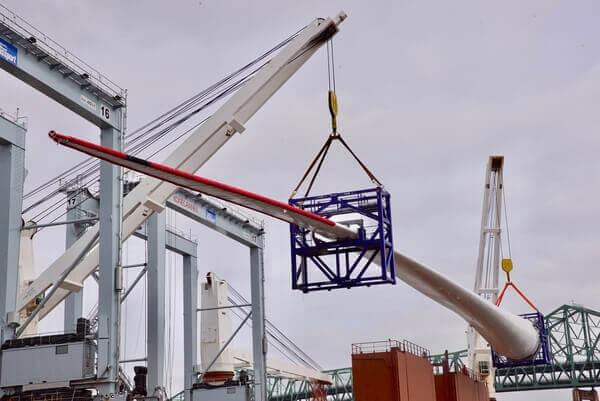News Release from GE Vernova
Wind Industry Profile of
Shore Leave: A 107-Meter-Long Blade For The World’s Most Powerful Offshore Wind Turbine Arrives In Boston For Testing
On Tuesday morning, GE Renewable Energy and the Massachusetts Clean Energy Center in Boston unveiled a wind turbine blade longer than a football field designed for GE’s Haliade-X 12 MW offshore wind turbine. The 107-meter-long blade will labor through a series of punishing fatigue tests at MassCEC’s Wind Technology Testing Center (WTTC) over the next few months. The test will simulate conditions the blade would encounter in more than 25 years in service at sea.
GE turbines started producing America’s first offshore electricity in Block Island, Rhode Island, in 2017. But the Haliade-X 12 MW is a machine like nothing the wind industry has seen before. When running offshore, each Haliade-X 12 MW turbine can generate up to 67 GWh of gross annual energy production. That’s enough clean energy to power roughly 5,000 U.S. households. “This has really been a collaborative effort on the part of the company to be part of solving the challenges associated with the energy transition,” said GE Chairman and CEO H. Lawrence Culp Jr., who visited the WTCC on Tuesday. “We think the Haliade-X is the right turbine at the right time as the offshore industry globally and particularly here in the US is poised to take off.”

The 107-meter-long blade designed for GE’s Haliade-X 12 MW offshore wind turbine will undergo fatigue tests at MassCEC’s Wind Technology Testing Center (WTTC) in Boston over the next few months. (Image: GE Renewable Energy)
No wonder the turbine has been turning heads. This fall, GE announced several massive deals in the U.S. and Europe involving the technology. For example, the Danish offshore wind farm developer Ørsted said it would use the Haliade-X to build Ocean Wind, a farm located off the coast of New Jersey that will be capable of generating 1.1 GW, the equivalent of an average nuclear reactor in the U.S. A joint venture involving the Norwegian energy giant Equinor and its partner SSE plans to use the turbines at Dogger Bank, located in the North Sea between the U.K. and Norway. At 3.6 GW, it is the world’s largest offshore wind installation.
“We believe the Haliade-X is the right turbine at the right time to supply the fast-growing offshore wind market in the U.S. and globally,” said John Lavelle, CEO of GE Renewable Energy’s Offshore Wind business. “Because it is the most powerful machine in the industry, it allows our customers to drive down the cost of wind energy and speed the adoption of clean, renewable energy.”
That’s because the longer blades allow the turbine to capture more wind and increase the new turbines’ expected “capacity factor” to 63%. For comparison, a report published by the International Energy Agency found that offshore wind has a typical net capacity factory closer to 40%.
The Global Wind Energy Council estimates that the world’s offshore wind market will grow to 120 GW by 2030. A number of U.S. states, including Massachusetts, have set ambitious offshore wind targets totaling nearly 20 GW. The University of Delaware’s Special Initiative on Offshore Wind estimates there is also a nearly $70 billion supply chain opportunity associated with the new industry.
The WTTC is the only location in the U.S. that can test and certify a blade of this size. GE is also testing blades and other components at a facility in Blyth, U.K., and the company has built a prototype of the turbine in Rotterdam in the Netherlands.
In October, the U.S. Department of Energy doled out several awards to support wind energy research, development, and demonstration projects, which included a grant to MassCEC for equipment upgrades at the WTTC to enable structural testing of 85-to-120-meter-long blades.
The Haliade-X 12 MW’s blade was produced by LM Wind Power, a GE Renewable Energy subsidiary, in Cherbourg, France, the only plant in the world right now capable of making these blades.
- Source:
- GE Renewable Energy
- Author:
- Tomas Kellner
- Link:
- www.ge.com/...
- Keywords:
- GE Renewable Energy, rotor blade, Boston, Haliade-X, wind turbine, record, testing, facility, offshore, MassCEC, WTTC, Europe



























